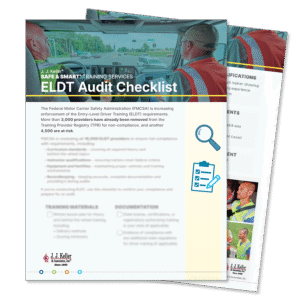With an average turnover rate that hovers around 100%, it’s obvious that the average professional driver changes jobs on a regular basis. Look at it like this: With a 100% turnover rate, a carrier has to hire enough drivers to replace its entire driving staff every year.
Obviously, not every driver in the U.S. changes jobs once a year — but the drivers who make two or more job changes each year push the average upward. Carriers bear much of the responsibility for the driver “churn” they help create, but that’s a topic for another story on another day. This story deals with leaving a carrier in a way that won’t keep you from getting another job in the future.
The Federal Motor Carrier Safety Administration (FMCSA) requires carriers to perform background checks on every driver they hire, including prior employment. The rules themselves are somewhat vague, and carriers have a little leeway in how much information they request — as well as how much info they provide to other carriers that want to hire their former drivers. Failing to check backgrounds does more than just violate regulations; it could make the carrier liable for negligent hiring if the driver has an accident while working there.
Most carriers use a service for initial background checks. The infamous “DAC report” is the most well-known of these, but there are others. The DAC is a product of HireRight, a consumer reporting agency that collects information and distributes it to subscribers. The company also provides other information, such as drug test results, state motor vehicle reports, credit reports and more.
You have a right to know what’s in your file. By law, you’re entitled to a copy. The HireRight website, hireright.com, has a form you can complete for a free copy, or you can call, fax or mail your request. Getting your own copy before you apply for a trucking job will help you make sure the information you put on your application matches what’s in your background report. If the background report is wrong, you have a right to ask that it be corrected — or at least include your statement of what happened.
For all too many drivers, negative information contained in the background report could have been avoided. Leaving your current job in the right way is one way to avoid negative content in your report.
One question drivers often ask is whether they should give their employer a two-week notice. While it’s a respectful way to end employment, unless you signed an employment contract stipulating penalties for not giving notice, it’s not required. After all, the carrier isn’t likely to provide a two-week notice of termination of employment, right? If your carrier is in a state with “at-will” employment laws, they are not required to even give you a reason for firing you.
There is, however, an incentive to leave your carrier on good terms, and with reasonable notice. After all, these are the folks who’ll be providing the information that goes in your employment record.
More important than providing notice is returning the carrier’s equipment to the proper place. It might be tempting to dump the truck and trailer at the nearest truck stop, but if you do, the carrier may enter a “truck abandonment” note on your record. Retrieving trucks is expensive, so a recruiter may ask questions about the incident. Your application could be turned down, especially if there is more than one such entry on your record.
If a customer’s load was in your trailer, or even if you accepted the load before quitting, your record might have “quit under dispatch” on it. If you drew your weekly advance from your fuel card and then quit, another entry might read “misappropriated company funds.”
The message, of course, is that it’s best to turn your truck in following the company’s instructions, if you can. It may mean picking up another load that gets you back to the home terminal or taking the truck farther from home and then making a bus trip home. When you resign, ask about the process. Many carriers are willing to pay for your transportation home if you cooperate with their turn-in instructions.
And don’t forget about your possessions. A carrier might be willing to pay bus fare, or even for a plane ticket, but there are restrictions on how much luggage you can carry. If you have a cooler, appliances, a month’s worth of laundry, tools and other items, they’ll need to be shipped home separately, and it’s not cheap. If possible, drop off as much as you can before you resign, or ask if the carrier can store your stuff while you make arrangements to pick it up or ship it.
One item that will certainly be on your record is your method of leaving, whether you quit (voluntary) or were fired (involuntary). Disputes often arise, but if your record indicates you were fired from multiple jobs, you might have a difficult time getting hired for another one.
Your record may also have an entry for your performance, and carriers are asked if they would consider rehiring you. If your report says “unsatisfactory” and “no rehire,” it’s not a good look, especially if there are similar entries from other carriers.
With the implementation of the Drug and Alcohol Clearinghouse at the FMCSA, access to your drug testing record is much easier than the old method of contacting each of your former employers. It’s much harder to hide a failed drug screen. On the other hand, if you complete a return-to-duty program after testing positive, the information is purged from your record after a few years. Under the old system, former employers could report drug test failures to future employers for the rest of your life, if they so chose.
Finally, as tempting as it might be to tell your dispatcher or fleet manager exactly what’s on your mind, keep in mind that they’ll be the ones telling the company’s safety or human resources department what information should go on your record. It’s not uncommon for an angry person to want to get back at a quitting driver by painting the worst possible picture on their work record.
Be calm and professional while you explain your reasons for leaving. Try to come to agreement on the date, where to leave the equipment, travel arrangements and so on. Don’t escalate the situation if you don’t have to.
Cliff Abbott is an experienced commercial vehicle driver and owner-operator who still holds a CDL in his home state of Alabama. In nearly 40 years in trucking, he’s been an instructor and trainer and has managed safety and recruiting operations for several carriers. Having never lost his love of the road, Cliff has written a book and hundreds of songs and has been writing for The Trucker for more than a decade.













